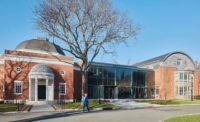Baltimore
People/Products
Built in 1914, the four-story industrial building at 1500 Barclay Street in Baltimore’s North Central Historic District was innovative for its time, with expanses of glass and a unique ventilation system designed by the architect, Otto G. Simonson, to improve working conditions. Nearly 100 years later, the masonry structure is again breaking new ground. Originally home of the Cork Crown & Seal Company, a bottle-cap manufacturer, and later occupied by the Lebow Brothers Clothing Company, a maker of men’s suits, the building has been transformed into the dynamic Baltimore Design School (BDS) by the Baltimore-based architect Ziger/Snead.
The existing 115,000-square-foot building had a leaky roof, spalling concrete, and thick vegetation growing out of its walls. It needed structural repairs, new windows, and a complete systems overhaul. “It was in such bad shape that it was used as a set for the popular TV crime drama The Wire,” says design principal Steve Ziger. There were still coat racks, sewing machines, and barrels of buttons from 1985 when the building was shuttered due to a labor dispute.
A gritty, formerly working-class neighborhood dotted with factories is not the first place you would think of locating a school for kids. Yet the founders of the BDS, a public school offering concentrations in fashion design, architecture, and graphic design to middle and high school students, knew it was right. Located near the city’s Pennsylvania Station, the Station North Arts and Entertainment District is a gentrifying neighborhood containing artist live-work lofts, theaters, galleries, row houses, and businesses, anchored by the nearby Maryland Institute College of Art (MICA). Adapting a historically significant abandoned building here, a district listed on the National Park Service’s National Register, would qualify BDS for community-investment and historic-preservation tax credits.
The school, which opened in 2011 at a temporary location, was the vision of State Senator Catherine Pugh, who pushed to provide the students with a new, state-of-the-art facility. In this endeavor, Pugh was assisted by a team of community leaders and professionals, including Ziger, MICA President Fred Lazarus (both on the school’s Board of Directors), and Dr. Andr's Alonso, former CEO of the Baltimore City Public Schools (BCPS). The $26.9 million project is the result of a unique public-private partnership financed by public and developer funding, tax credits, private bonds, and fund-raising. A local developer was tapped by the BDS board to arrange and manage financing, design, and construction.
“The guiding architectural idea was to have a dialogue between the historic structure and the new work,” explains Ziger. “We wanted the intervention to be clear and simple. And we wanted to keep those ideas throughout.” To do this, Ziger/Snead maintained as much of the existing structure as possible. The architects gutted the building, cleaned the brick, and installed energy-efficient windows with profiles replicating the original ones. They created a series of loftlike spaces, configuring them to encourage collaboration, adding modular pods between the classrooms and the hallway to facilitate point-of-use storage and mechanical needs. Each of these discrete 5-by-16-foot units houses such elements as lockers, computer stations, and teachers’ cabinets, as well Variable Air Volume boxes, air supply, and acoustic panels. “The pods were conceived as a way of organizing a variety of program elements in a clearly new component,” says Ziger. While standardized, the pods vary to suit programmatic needs.
One of the biggest challenges was to design code-compliant stairs within a tight budget. Taking their cues from Diller Scofidio + Renfro’s High Line in New York, the architects filled the core of an existing interior stairwell with woven stainless-steel netting that stretches the full-height of the building. Outside, they suspended two corrugated-aluminum-wrapped stairways diagonally along facing walls of the courtyard, now used as a place to gather or watch fashion shows staged on the former loading dock.
Construction costs totaled $19 million, or $164 per square foot, which is lower then the $225 per square foot the BCPS typically budgets for this type of work. Dollars were further stretched through a number of pro-bono services and professional relationships. Adobe Foundation’s Youth Voices Program sponsors a creative lab staffed by an Adobe instructor and equipped with computers loaded with the company’s Creative Suite. Luke Works, a local designer of concrete surfaces and furnishings, gave sinks. Ziger/Snead, Gensler, and Ayers St. Gross donated interior-design services. Ashton Design pitched in with environmental graphics. Much of the furniture outside of classrooms was donated, and the bright-orange cafeteria chairs, discovered at NeoCon East, were purchased for under $70 apiece.
The raw look of the building, that of a “work in progress,” is intended to inspire the students. “If you engage design thinking early enough in a kid’s life, he or she can apply those skills to solving life’s problems,” says Ziger.
A fresh approach to school design—and community development—the Baltimore Design School’s new home is exciting, open, and transparent, crafted largely through a thoughtful design process and goodwill. “To know that these kids can have a voice and make a difference is huge,” says Ziger. “It’s a message filled with hope.”
Abitare World Architecture News.
People
Architect:
Personnel in architect's firm who should receive special credit:
Project Team:
Interior designer:
Engineers:
Civil:
Structural:
Consultant(s):
Acoustical:
Life Safety:
Food Service:
Graphics:
General contractor:
Photographer(s): Size: 115,000 square feet Cost: $26.9 million Completion date: June 2013 |
Products
Structural system
Exterior cladding
Metal/glass curtain wall:
Curtain wall:
Masonry and concrete restoration:
Roofing
Other:
Windows
Glazing
Doors
Metal doors:
Wood doors:
Hardware
Closers:
Exit devices:
Pulls:
Security devices:
Other special hardware:
Interior finishes
Suspension grid:
Cabinetwork and custom woodwork:
Paints and stains:
Paneling:
Plastic laminate:
Solid surfacing:
Floor and wall tile:
Resilient flooring:
Carpet:
Existing stair guard netting:
Furnishings
Reception furniture:
Chairs:
Tables:
Upholstery:
Lighting
Downlights:
Exterior:
Dimming System or other lighting controls:
Conveyance
Accessibility provision:
Plumbing
Faucets:
Fixtures:
Flushing:
Water Fountain:
Fume Hood: |




















